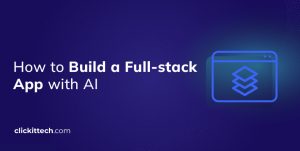If you’re going to create a web or mobile application but don’t feel like managing servers, then you’ve probably already heard of Supabase vs Firebase.
Both are top-tier Backend-as-a-Service (BaaS) solutions that make development quicker and more convenient. With the click of a few buttons, you can create databases, authentication, APIs, and more, all without laying hands on a single server.
In this blog post, I am going to lay out the main differences between Supabase vs Firebase in plain, easy-to-understand language, providing you with a good idea of why this contrast has become such a hot issue among developers.
Notably, as of late 2025, both Firebase and Supabase have evolved with new trends – Firebase introduced tools for easy integration of AI (e.g. GenAI APIs and Firebase GenKit) while Supabase added support for advanced features like vector embeddings via PostgreSQL (pgvector) to power AI-driven app
Firebase is built on a NoSQL document database, which is excellent for prototyping and flexibility. Think of it like you could store everything in a massive digital filing cabinet, but it wouldn’t be able to link the files in an orderly fashion.
On the other hand, Supabase is built on the traditional relational database PostgreSQL. Comparable to a highly organized spreadsheet, this is perfect for handling structured data with clearly defined relationships.
From startup MVPs to AI-ready platforms, ClickIT’s experts architect your Firebase or Supabase backend. Hire our engineering team.
Comparison Between Firebase vs Supabase
| Supabase vs Firebase Comparison Features | Supabase | Firebase |
| Core Database | PostgreSQL (Relational / SQL) | Firestore (NoSQL / Document-based) |
| Open Source | 100% Open Source (No Vendor Lock-in) | Proprietary (Managed by Google) |
| Data Model | Structured schema, strong data integrity, supports complex SQL Joins. | Schema-less, flexible JSON-like documents, ideal for simple data. |
| Realtime/Offline | Realtime via WebSockets; Offline support is less mature. | Excellent, mature real-time sync; Strong offline-first SDKs. |
| Security | Granular control via Row-Level Security (RLS) using SQL policies. | Declarative, simpler Security Rules for quick setup. |
| Serverless | Edge Functions (Deno) for low-latency; SQL-centric workflows. | Cloud Functions (Node.js, Python) deeply integrated with Google Cloud. |
| Pricing | Predictable fixed monthly subscriptions. | Pay-as-you-go (Blaze Plan); Costs can spike unpredictably. |
| Use Case | Apps needing structured data, enterprise needs, long-term control. | Rapid prototyping, mobile-first apps, real-time chat. |
What’s the Difference Between Supabase vs Firebase?
Throughout this comparison of Firebase vs Supabase, we’re going to specifically and closely focus on six major areas where developers spend the most time debating Supabase vs Firebase:
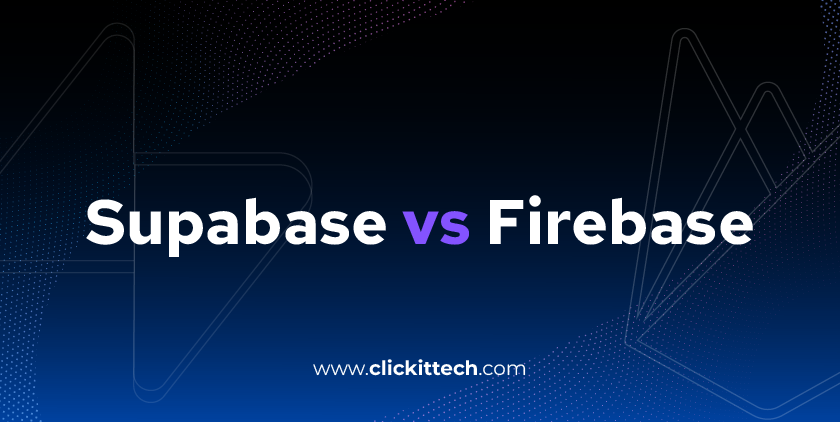
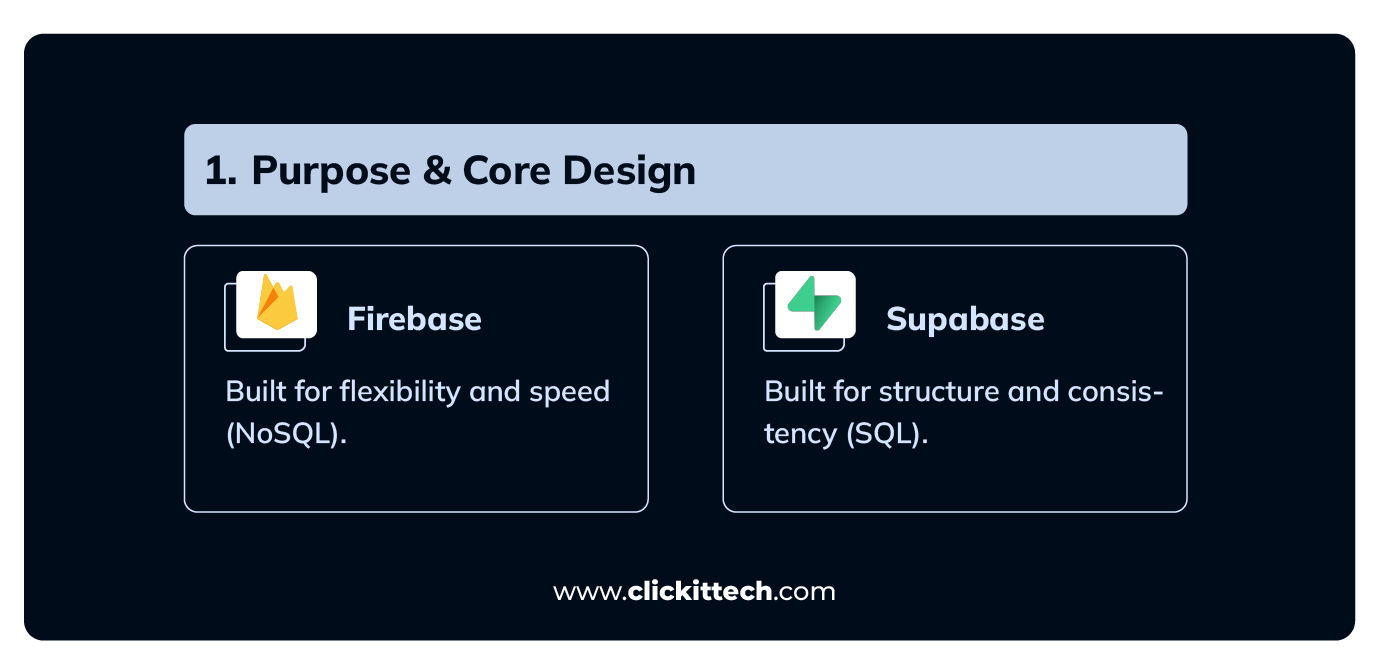
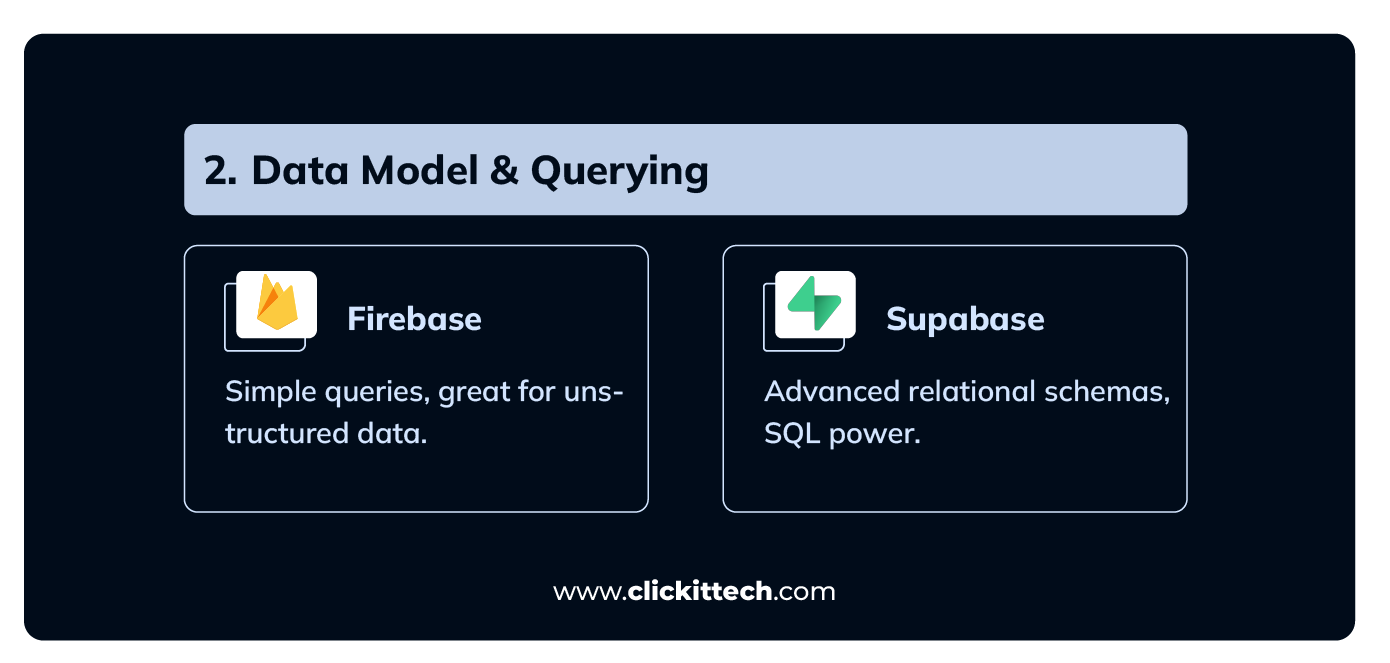
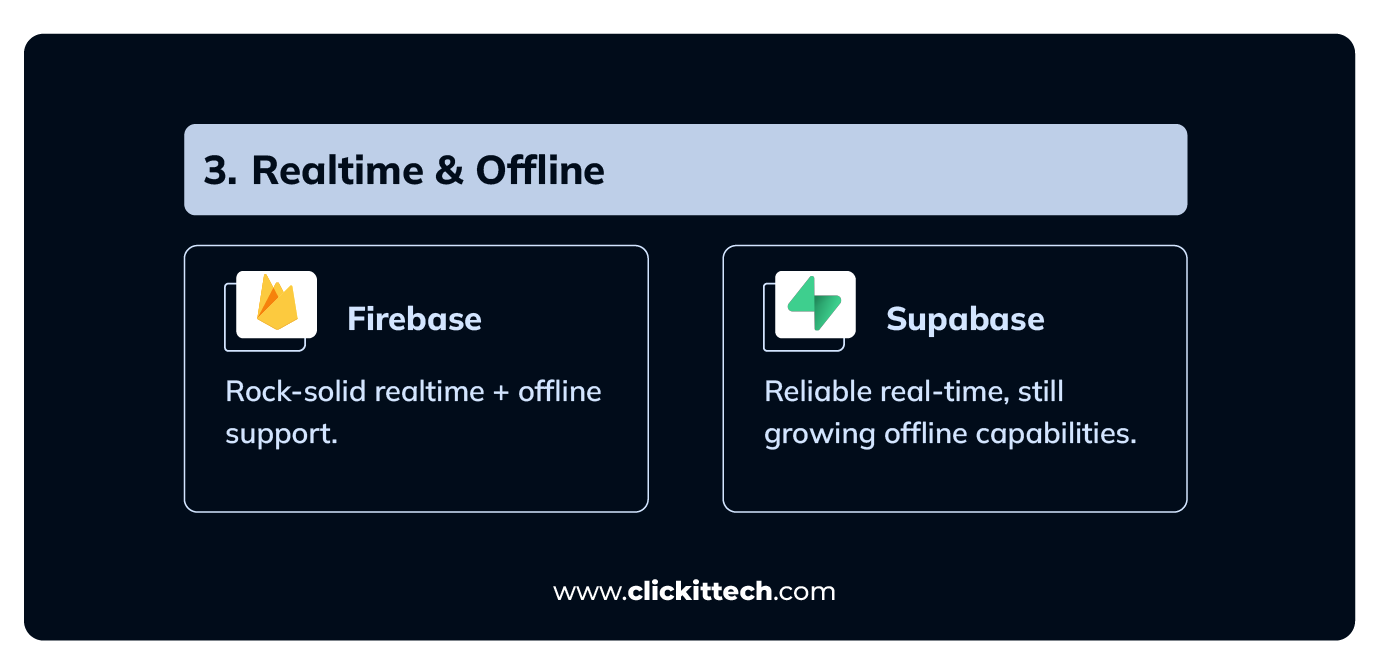
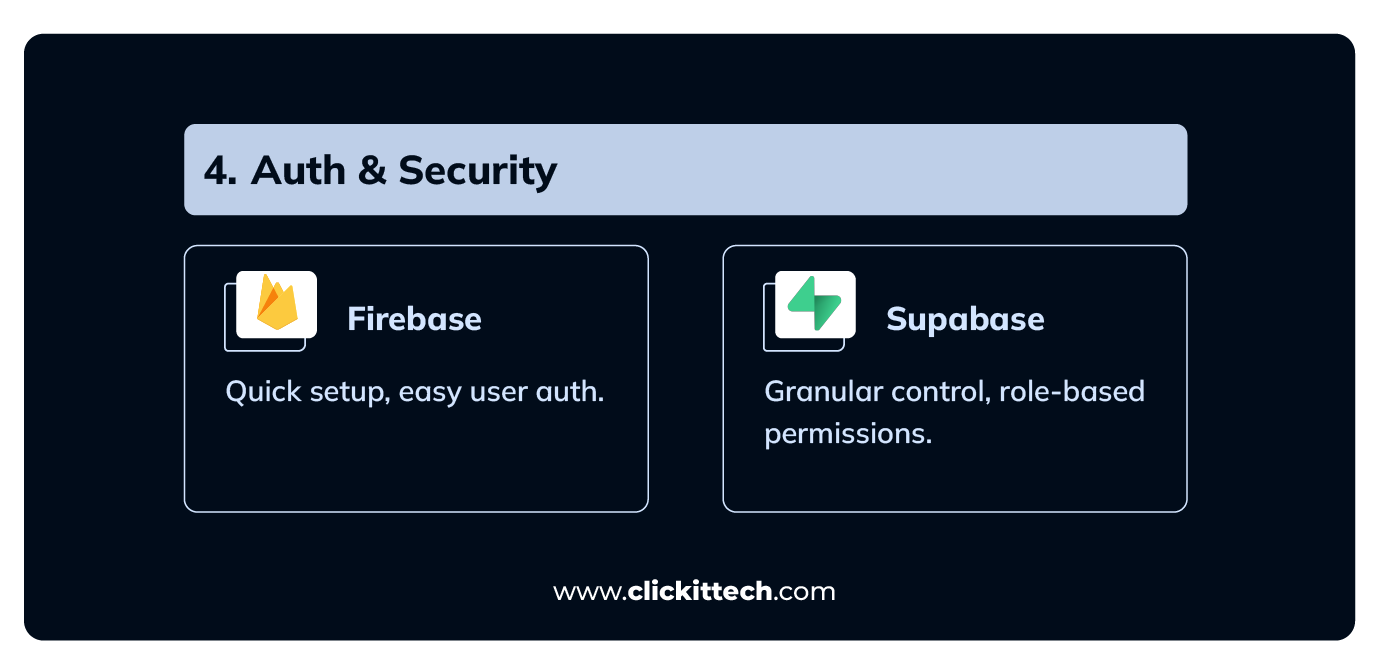
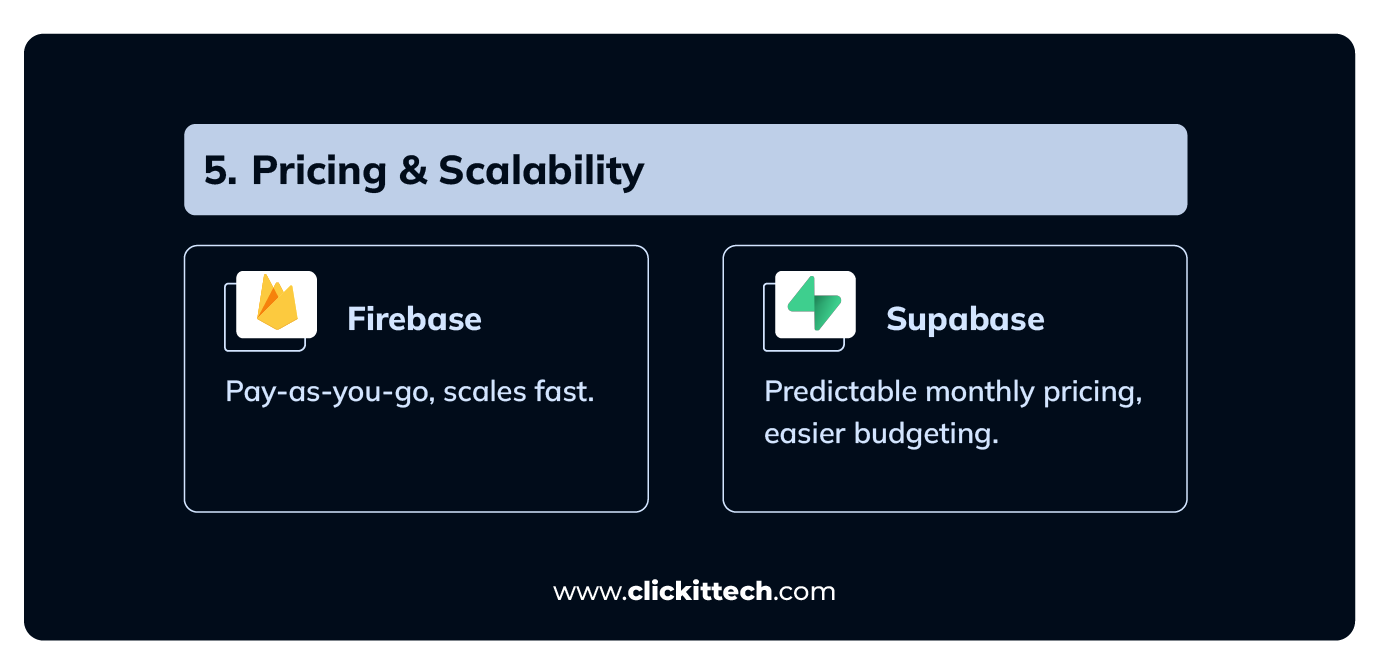

- Purpose and Design: Let’s get to the core: Why does each one exist? What was the original mission, and what task is each platform truly built to dominate?
- Data Models and Querying: How is your data stored, accessed, and organized? This is the big one: Are we talking SQL or NoSQL?
- Realtime and Offline: How reliable is your app when the internet gets shaky or flat-out disappears? We’re talking about that “keeps on humming” performance for your users.
- Auth & Security: How safe, secure, and easy is it to manage user sign-ups, logins, and permissions?
- Functions & Integrations: What kind of backend automation and outside-the-box connections can you actually set up?
- Pricing Models: Let’s talk money. What’s the bill going to look like as your user base explodes?
By digging into these six vital areas, you’ll move past the marketing hype and get a crystal-clear, practical sense of the differences. That’s how you make the real informed choice for your next project, whether you’re just messing around with a quick prototype or building the next big thing.
| Use Case / Project Type | Choose Supabase If… | Choose Firebase If… |
| Data Structure | Apps requiring complex relationships, joins, or transactions (e.g., ERP, E-commerce). | Apps with simple, denormalized data (e.g., profile settings, basic content). |
| Team Expertise | Your team is SQL-savvy and values relational database tools. | Your team is mobile-focused (Flutter/Android) and prefers NoSQL flexibility. |
| Speed Goal | You need to scale and ensure data integrity for the long term. | You need the fastest possible MVP and quick prototyping. |
| Connectivity | Offline support can be built in later with custom logic. | Bulletproof real-time chat and mature, out-of-the-box offline support are essential. |
| Vendor Choice | You require open-source freedom, self-hosting options, and no vendor lock-in. | You are heavily invested in the Google Cloud Ecosystem (Analytics, AdMob). |
| Pricing | You need predictable, fixed monthly costs as your app grows. | You have low, unpredictable usage and want to pay strictly per operation. |
What’s the Difference Between Supabase vs Firebase in Purpose and Design?
To really compare Supabase vs Firebase, you have to start with their DNA. They were built for entirely different reasons.
The Short Story: Firebase is optimized for flexibility and rapid iteration, while Supabase is better for structured, relational data applications where data consistency matters.
- Firebase: Firebase is designed to help you ship fast. Its core strength is rapid development and built-in real-time functionality. Because it uses a NoSQL, document-based model, you can stuff data in without worrying about rigid schemas.
It is perfect for chat apps, quick MVPs, and mobile-first projects where data is messy and changes constantly. Since Google Cloud fully manages it, you truly never have to think about servers, scaling, or infrastructure maintenance.
- Supabase: Supabase, on the flip side, is built around PostgreSQL, which is an incredibly robust, relational SQL database. This means Supabase puts huge emphasis on structured data, clear relationships, and, most importantly, data integrity.
The fact that it’s open-source and supports self-hosting gives developers significantly more control over their backend setup. This makes it ideal for apps like e-commerce platforms, financial applications, and systems that rely on complex data relationships.
Read our blog PostgreSQL vs MySQL
How do Data Models and Querying Work for Supabase and Firebase?
The choice of database essentially changes how you build and query your app.
The Short Story: Firebase is for flexible, unstructured data where queries are simple. Supabase is the clear winner for applications that need relational data schemas and advanced querying abilities.
- Firebase: Firebase’s NoSQL document-oriented structure eliminates a strict schema. Information is stored as loose, JSON-like blobs. This schema-less arrangement is wonderful when you’re moving quickly, but it falls short with complex requests. Want to combine data from two or more “tables” or run thorough aggregations? You tend to have to do coarse workarounds in client code.
- Supabase: Supabase introduces relational goodness of PostgreSQL. You get standard tables, foreign keys, and all the relational goodness. This allows it to be much easier to enforce data rules, maintain your data clean, and most importantly, do complex SQL joins and aggregations in-place and performant on the server.
Difference Between Supabase vs Firebase in Realtime and Offline Capabilities?
For any application that relies on live data or needs to function reliably when the connection gets shaky, real-time and offline support is absolutely crucial and often the deciding factor.
The Short Story: Look, if you’re building a chat app, a live dashboard, or any collaborative tool where a bulletproof offline experience is non-negotiable, Firebase is the safer, more established choice today.
Supabase is definitely catching up, but budget time for extra development if that top-tier offline reliability is a must-have.
- Firebase: Firebase is a mature platform with well-established real-time capabilities. It offers excellent, mature real-time support where any data change hits all connected clients instantly. Even better, its offline support is top-tier. Firebase-enabled apps can keep functioning seamlessly, letting users read and write data even if they drop off Wi-Fi or lose cellular service.
- Supabase: Supabase handles the real-time updates just fine – it delivers them using WebSockets, which works well. The catch, though? Its offline support just isn’t as mature yet. If you decide to go with Supabase, you need to be prepared: you’ll likely have to build or integrate your own custom caching and offline strategies to match the robustness of what Firebase hands you right out of the box.
Read our blog, Node.js vs Python: Which Backend is Better?
How does authentication and Security work for Supabase and Firebase?
Securing user access is a major development headache, and these platforms tackle it differently. It’s a trade-off between ease-of-use and granular control.
The Short Story: If you require run-of-the-mill authentication with a minimum of hassle, Firebase is the way to go.
If your app requires serious, customizable, role-based access control to individual rows of data, Supabase is the better and more adaptable option.
- Firebase: It gives you a highly polished, pre-built auth suite that handles pretty much everything: email/password, phone sign-in, and all the big social logins. Security is managed through simple, declarative Security Rules. They’re quick to set up, but they don’t allow for super complex, fine-tuned logic.
- Supabase: Supabase includes all the normal stuff as well; password, magic link, one-time password (OTP), social login, and single sign-on (SSO). But its security center is not the same: it leverages PostgreSQL’s Row-Level Security (RLS). It’s certainly more complicated to set up in the first place, since you’re authoring actual SQL policies. However, you have fine-grained, customizable control over who can read, write, or modify individual rows of data based on a user’s role or ID.
How much does Supabase and Firebase Cost?
Firebase is ideal for real-time-heavy apps, thanks to its scalable, pay-as-you-go model. Supabase gives you the predictable monthly costs that finance teams love. You buy a larger-capacity bucket like, the $25 Pro plan and know exactly what you get.
- Firebase: Firebase offers a fantastic Spark free plan, which is perfect for tiny apps and just messing around. Once you scale, you jump onto the Blaze plan, which is strictly pay-as-you-go. Your costs are tied directly to every little thing you do: reads, writes, storage, and bandwidth. While that’s flexible for light use, the major risk is this: high-traffic periods or viral spikes can instantly lead to unpredictable and scary bills. You’re constantly tracking micro-operations.
- Supabase: Supabase offers a generous free tier as well, but its paid model is based on fixed monthly subscription plans (with add-ons for things like extra storage). This is a game-changer because it makes your pricing much more predictable as you grow. Knowing your core monthly expense upfront is a huge relief for budgeting production apps that have consistent, steady traffic.
How do Functions and Integrations work for Supabase vs Firebase?
The last piece of the puzzle, and it’s a critical one, is what each platform does for your custom server-side code, or as everyone calls them, serverless functions, and how well they communicate with other systems.
The Short Story: Firebase has the proven, deeply integrated serverless tech for the Google world. Supabase offers newer, flexible edge functions that are definitely better suited for relational stacks and apps where low latency is your main goal.
- Firebase: Firebase has one of the most mature and proven Cloud Functions implementations. This stuff is seriously mature and lets developers run serverless backend logic. It can be triggered by a database change, a new sign-up, or just a simple API call. The massive, massive advantage is that it’s tightly woven into the entire Google ecosystem. If you’re using other Google tools, the automation is basically seamless.
- Supabase: Supabase fights back with Edge Functions. They’re built on Deno and they run right at the edge, which means they’re geographically much closer to your users. This is huge for low-latency operations where speed really counts. Because it’s built on PostgreSQL, its functions are really good at integrating directly with the database, RESTful APIs, and the wider open-source world. It’s super flexible if you prefer SQL-centric workflows.
When to use Supabase vs Firebase?
Which one should you actually use for your project? The answer lies in what your app requires, team expertise, and long-term aims.
- Choose Firebase if you want speed, simplicity, and ready-to-use managed services for real-time, mobile-first apps.
- Choose Supabase if you want flexibility, SQL querying power, open-source transparency, and more control over your backend.
When should I use Firebase?
- Mobile-first apps: You’re building mobile-first apps. Especially if you’re working with Android or Flutter, Firebase’s SDKs are incredibly seamless and its built-in real-time sync is ready to go right out of the box.
- MVPs and prototypes: Firebase excels when speed to deployment is your top priority. Its fully managed infrastructure and super simple setup mean zero wasted time on servers.
- Real-time-heavy apps: Your app is real-time intensive. Think chat applications, collaborative tools, or those live sports dashboards. Firebase’s original architecture is inherently optimized for instant, constant updates.
- Tight Google ecosystem use: If you’re already using Google Cloud services (e.g., BigQuery, Analytics, ML APIs), Firebase fits perfectly.
When should I use Supabase?
- SQL-first teams: If your team is SQL- and relational database-savvy, Supabase is the obvious choice. Its PostgreSQL roots provide you with flexibility and might.
- Data consistency matters: Apps that require strong relationships, constraints, and structured data (e.g., e-commerce, finance, ERP systems) benefit from Supabase’s relational model.
- Open-source preference: Supabase is completely open-source. That means you avoid vendor lock-in and can even self-host the whole stack if you want maximum control.
- Custom backend needs: If you plan on extending functionality, writing custom stored procedures (SQL), or building specific server-side workflows, Supabase gives you way more freedom than Firebase.
Ultimately, the decision in the Supabase vs Firebase debate boils down to whether your app is a rapid real-time mobile app (Firebase) or a scalable, SQL-driven web and enterprise app (Supabase). What skills does your team have, and what does your data actually need?
Which One is Better Supabase vs Firebase?
Firebase is practically unbeatable for rapid prototyping, building mobile-first apps, and anything that requires instant, reliable real-time functionality. If speed and simplicity are your top concerns, it’s a guaranteed win. Plus, if you’re already plugged into Google Cloud, the integration is seamless.
Supabase, in contrast, hands you the immense power of PostgreSQL, total open-source freedom, and fine-grained control over your entire backend. It’s ideal for teams where SQL querying horsepower, organized data, and vendor lock-in-free, long-term scalability are top priorities.
Ultimately, your decision between Supabase vs Firebase comes down to three things: your team’s expertise, your data model, and your growth goals.
Want something fast and frictionless right now? Go with Firebase. Need flexibility, control, and enterprise-level SQL robustness? Supabase is your best bet.
The real key to success isn’t picking the “better” platform, but picking the one that aligns perfectly with your app’s core vision.
Not sure which backend fits your app? We master both! Real-time speed meets SQL power.
FAQs
The absolute biggest difference is what they use for their core database. Firebase runs on a NoSQL document store (Firestore). Supabase, on the other hand, gives you a powerful SQL-based solution (PostgreSQL). That one choice dictates pretty much everything else about how you build your app.
No, not really. They’re just built for different jobs. Supabase wins out for projects that need structured data, complex relationships, and the flexibility of an open-source, SQL environment. Firebase is the superior choice if you’re building mobile-first apps, need bulletproof real-time functionality, or your top priority is quick prototyping.
Supabase handles real-time data flow perfectly fine, but its dedicated offline support is still catching up. Firebase currently has much stronger, more reliable offline-first capabilities, making it the safer option if your app needs to function reliably without a constant internet connection.
Yes, Supabase is 100% open source. That means you have the freedom to self-host the platform and avoid vendor lock-in. Firebase, however, is a proprietary platform entirely owned and managed by Google Cloud.




